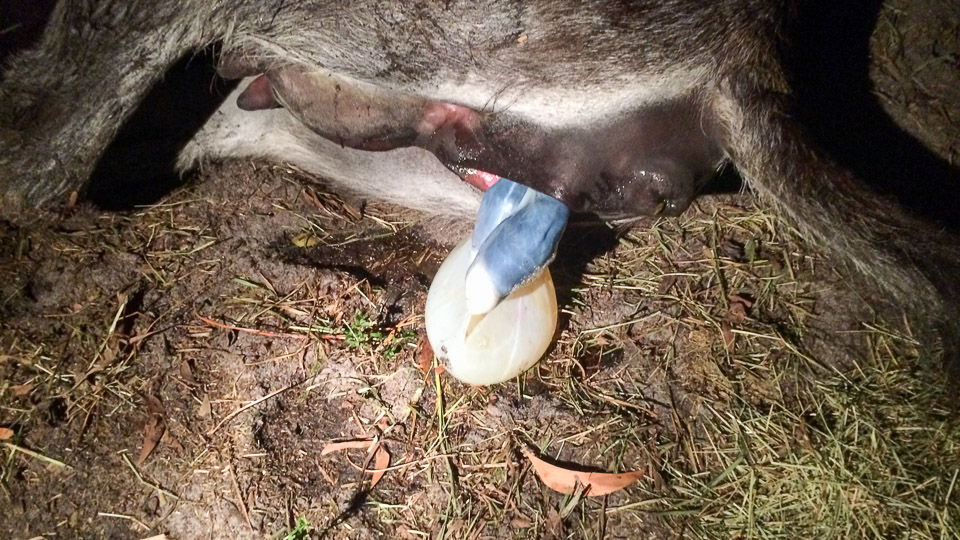
Foal Delivery – An Introduction
I love the birth of a foal more than anything else concerning horses. For the most part it is an exciting and explosive event few horse owners get to see as they usually occur in the quiet early morning hours. 90 out of 100 births go without problems and of the remaining 10 births, about 9 have small and easily resolved problems. It is the remaining 1%, the 1 in 100, that are what we all live in fear of happening to our mares.
This subject shows a normal birthing (of a donkey but it’s the same as a horse both small and large). It also shows you how to handle the most common cause of a difficult birth (elbow lock) as well as the one event you will not have time to wait for help (red sack delivery).
I’ll also look at some of the permpartum (right after the birth) things that are normal (nursing) and that are not normal (orphan). I will tell stories of helping a mare in shock after foaling and her life ending injuries, mares successfully birthing and suddenly dying and of mares retaining their afterbirth (placenta) and what was done.
There’re many more subtle things that happen that are unique to every birth and that take hundreds of birth observations for you to start to become comfortable with. There are degrees of pain and pushing that only experience can teach. There are folks that take hours to find the milk while others take only a few attempts. You just need to attend and hopefully attend with an experienced mentor to become good at this.
I will never forget my first foaling and my first difficult birth. I also spent a year calving during my first year out of vet school where I saw things I couldn’t believe happen (amorphous globosus, hydrocephalus, Schistosomus reflexus and other fetal monsters). I have seen foals born without front limbs and a few born with an extra digit (secondary cannon, pastern and hoof).
Delivering foals is exhilarating but is not for the faint of heart nor is it for those who lose their composure quickly or those who freeze when action needs to be taken. If you want to become good at helping the delivery of foals then observe as many as you possibly can. Experience with mentorship is the best teacher.
Foal Delivery – Birth (Parturition)
I loved delivering foals. It is a miracle and also a pleasant challenge for me when they went wrong. Maybe not pleasant for the mare or the owner but for me it was a puzzle I always solved.
Here is the facts. 90 out of 100 deliveries go without a problem. Of the remaining 10, 9 usually have “elbow lock” which with the video I made here, all horse owners can resolve without their vet.
Then there is the 1 in 100 that get stuck and often cause the death of the foal, the mare or both. These are the reason you stay up all night on foal watch and have your vet on speed dial. These are the ones I drove through blinding snow storms to go to. I loved delivering foals.
Foal Delivery – Elbow Lock
A normal foal delivery has both front hooves coming out of the birth canal with about 3 to 4 inches difference in the distance from the mare to the foal’s toe. With an elbow lock delivery, one limb is about a foot behind the other because the shorter limb is flexed at the elbow. This causes the foal’s diameter to become too big for the birth canal and the foal’s delivery is obstructed.
Foal Delivery – Inducing Birth In Mares
An excerpt is coming soon.
Foal Delivery – Nursing Foals
In every mammal, the baby nurses from the mother. In horses, it is an orchestrated event with fine points that amaze me still. How can an hours-old baby get up and walk and then find a spot underneath the mother the size of your hand to fine the life giving milk? It is a sight I will never tire of.
Foal Delivery – Orphan Foals
An excerpt is coming soon.
Foal Delivery – Rectal Vaginal Fistula In Mares
An excerpt is coming soon.
Foal Delivery – Red Sack Foal Delivery
The red sack foal delivery is really the premature separation of the foal’s placenta from the lining of the uterus. This diminishes the flow of blood to the unborn foal causing a lack of oxygen to the foal. Temporary to permanent brain damage and even death can occur. There is no time to call for help.
Foal Delivery – Retained Placenta In The Mare
An excerpt is coming soon.
Foal Delivery – Ruptured Uterine Artery In Mares
An excerpt is coming soon.
Foal Delivery – Signs Of Impending Birth In Mares
An excerpt is coming soon.
Foal Diseases – Fetal Malformations
An excerpt is coming soon
Foal Diseases – Fetal Monsters
An excerpt is coming soon.
Horse Reproduction -Mare Cycles and Foal Delivery – a HorseTalk™ Webcast
This is a replay of a HorseTalk™ webcast. Be sure to enroll in the next one and join Doc T live.


Responses